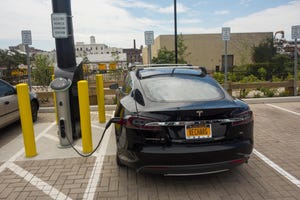Mobile Video Goes on the Road
In-vehicle video is taking off, but quality requirements are causing some carmakers to consider Ethernet

Anyone who has ever taken a road trip with children can appreciate why the mobile video market is taking off in cars. Smartphones, tablets, DVD players, rear-seat entertainment panels and navigation units have become the heroes of the road, but how they are connected is still up for debate.
Mobile video has been the bane of operators' existence on their wireless networks, which is why a number of car manufacturers are looking towards alternative network technologies to build high-definition services that can keep up with highway speeds.
Luca DeAmbroggi, senior analyst for automotive infotainment at IHS, says that the decision of wired versus wireless hinges on "cost, long-term semiconductor support from suppliers, readiness for integration within the vehicle, and issues related to performance and quality."
The automotive industry is already choosing sides. Deutsche Telekom AG is working with BMW to embed Wi-Fi in vehicles, while Verizon is part of the LTE car consortium comprising BMW, Honda, Hyundai Motor Company, Kia Motors and Toyota. Sprint and Chrysler are planning the full suite of wireless, with 3G, LTE and Wi-Fi connectivity. Others, like big dog General Motors, are holding off on embedded connectivity for now, instead relying on smartphones to interface.
But backseat entertainment is far from the only connection in the car, and LTE is far from the only option. IHS suggests that as OEMs tackle backseat entertainment alongside infotainment systems for traffic displays, safety applications, and hands-free entertainment up front, wired technologies will come into play.
An automotive version of Ethernet might soon be available with support from key auto companies, IHS writes in a research note. BMW, for one, is building Ethernet AVB into its first pilot vehicles this year and next and plans to have a complete Ethernet-cabled car by 2020. High-end vehicle brands are also exploring a dedicated network architecture called Media-Oriented Systems Transport (MOST). IHS says a host of other acronymic wired technologies, including LVDS, APIX, HDMI and MHL are also vying for a spot in the car.
The move to wired is being driven by an increase in bandwidth and safety app requirements, but wireless technologies like 802.11ad (WiGig), WirelessHD, WHDI, WiDi/Miracast and Multistream Wi-Fi are also of interest to carmakers for their cost savings and ease of transfer. With wireless, however, interference remains a concern for critical safety apps.
Whatever technology ends up ruling the road, the growth is having a positive effect on the semiconductor industry, which is poised to double its business in automotive wired and wireless network applications from 2011 to 2018, according to IHS. The firm finds that the market will climb from US$545.1 million last year to $585.4 million this year, $663.4 million in 2014, and surpass $800 million by 2017.
— Sarah Reedy, special to Light Reading
About the Author(s)
You May Also Like












